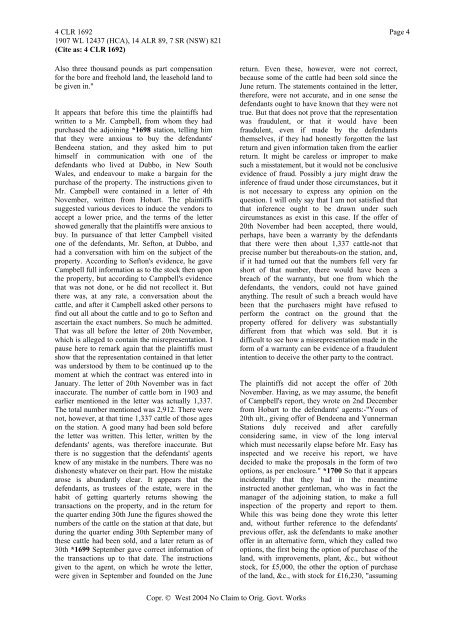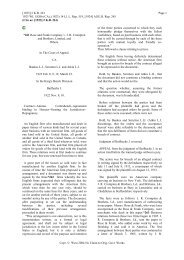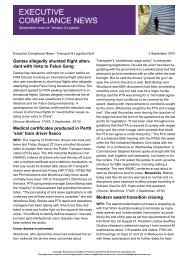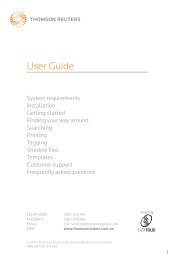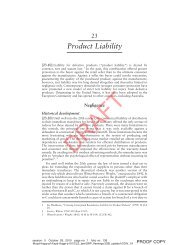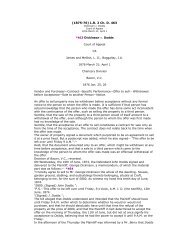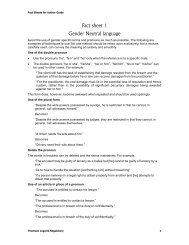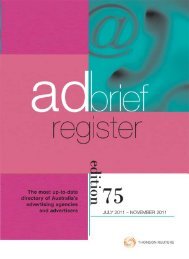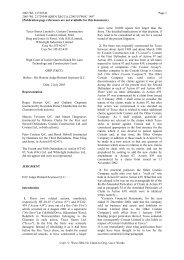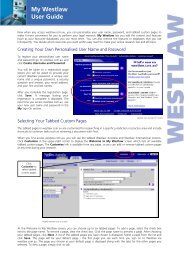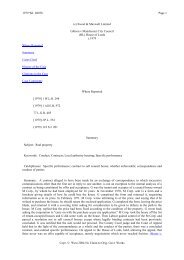Holmes v Jones - Thomson Reuters
Holmes v Jones - Thomson Reuters
Holmes v Jones - Thomson Reuters
- No tags were found...
You also want an ePaper? Increase the reach of your titles
YUMPU automatically turns print PDFs into web optimized ePapers that Google loves.
4 CLR 1692 Page 41907 WL 12437 (HCA), 14 ALR 89, 7 SR (NSW) 821(Cite as: 4 CLR 1692)Also three thousand pounds as part compensationfor the bore and freehold land, the leasehold land tobe given in."It appears that before this time the plaintiffs hadwritten to a Mr. Campbell, from whom they hadpurchased the adjoining *1698 station, telling himthat they were anxious to buy the defendants'Bendeena station, and they asked him to puthimself in communication with one of thedefendants who lived at Dubbo, in New SouthWales, and endeavour to make a bargain for thepurchase of the property. The instructions given toMr. Campbell were contained in a letter of 4thNovember, written from Hobart. The plaintiffssuggested various devices to induce the vendors toaccept a lower price, and the terms of the lettershowed generally that the plaintiffs were anxious tobuy. In pursuance of that letter Campbell visitedone of the defendants, Mr. Sefton, at Dubbo, andhad a conversation with him on the subject of theproperty. According to Sefton's evidence, he gaveCampbell full information as to the stock then uponthe property, but according to Campbell's evidencethat was not done, or he did not recollect it. Butthere was, at any rate, a conversation about thecattle, and after it Campbell asked other persons tofind out all about the cattle and to go to Sefton andascertain the exact numbers. So much he admitted.That was all before the letter of 20th November,which is alleged to contain the misrepresentation. Ipause here to remark again that the plaintiffs mustshow that the representation contained in that letterwas understood by them to be continued up to themoment at which the contract was entered into inJanuary. The letter of 20th November was in factinaccurate. The number of cattle born in 1903 andearlier mentioned in the letter was actually 1,337.The total number mentioned was 2,912. There werenot, however, at that time 1,337 cattle of those ageson the station. A good many had been sold beforethe letter was written. This letter, written by thedefendants' agents, was therefore inaccurate. Butthere is no suggestion that the defendants' agentsknew of any mistake in the numbers. There was nodishonesty whatever on their part. How the mistakearose is abundantly clear. It appears that thedefendants, as trustees of the estate, were in thehabit of getting quarterly returns showing thetransactions on the property, and in the return forthe quarter ending 30th June the figures showed thenumbers of the cattle on the station at that date, butduring the quarter ending 30th September many ofthese cattle had been sold, and a later return as of30th *1699 September gave correct information ofthe transactions up to that date. The instructionsgiven to the agent, on which he wrote the letter,were given in September and founded on the Junereturn. Even these, however, were not correct,because some of the cattle had been sold since theJune return. The statements contained in the letter,therefore, were not accurate, and in one sense thedefendants ought to have known that they were nottrue. But that does not prove that the representationwas fraudulent, or that it would have beenfraudulent, even if made by the defendantsthemselves, if they had honestly forgotten the lastreturn and given information taken from the earlierreturn. It might be careless or improper to makesuch a misstatement, but it would not be conclusiveevidence of fraud. Possibly a jury might draw theinference of fraud under those circumstances, but itis not necessary to express any opinion on thequestion. I will only say that I am not satisfied thatthat inference ought to be drawn under suchcircumstances as exist in this case. If the offer of20th November had been accepted, there would,perhaps, have been a warranty by the defendantsthat there were then about 1,337 cattle-not thatprecise number but thereabouts-on the station, and,if it had turned out that the numbers fell very farshort of that number, there would have been abreach of the warranty, but one from which thedefendants, the vendors, could not have gainedanything. The result of such a breach would havebeen that the purchasers might have refused toperform the contract on the ground that theproperty offered for delivery was substantiallydifferent from that which was sold. But it isdifficult to see how a misrepresentation made in theform of a warranty can be evidence of a fraudulentintention to deceive the other party to the contract.The plaintiffs did not accept the offer of 20thNovember. Having, as we may assume, the benefitof Campbell's report, they wrote on 2nd Decemberfrom Hobart to the defendants' agents:-"Yours of20th ult., giving offer of Bendeena and YunnermanStations duly received and after carefullyconsidering same, in view of the long intervalwhich must necessarily elapse before Mr. Easy hasinspected and we receive his report, we havedecided to make the proposals in the form of twooptions, as per enclosure." *1700 So that it appearsincidentally that they had in the meantimeinstructed another gentleman, who was in fact themanager of the adjoining station, to make a fullinspection of the property and report to them.While this was being done they wrote this letterand, without further reference to the defendants'previous offer, ask the defendants to make anotheroffer in an alternative form, which they called twooptions, the first being the option of purchase of theland, with improvements, plant, &c., but withoutstock, for £5,000, the other the option of purchaseof the land, &c., with stock for £16,230, "assumingCopr. © West 2004 No Claim to Orig. Govt. Works


